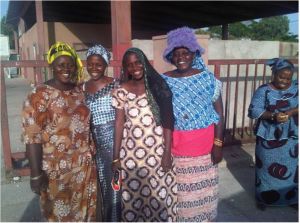
Women fish processors in Sokone, Senegal. Photo: Robert Lee, FAO.
In a recent FAO report (A Review of Women’s Access to Fish in Small Scale Fisheries), Angela Lentisco and Robert Lee have gone beyond the typical portrayal of women as fish processors and marketers have reviewed and categorized three main ways in which women access fish in small scale fisheries. First is primary access through fishing and financing/owning fishing operations; second is through close personal relationships including family; and third is through the normal purchases. By conceptualising women’s access in this more structured way, policy and action to assist women’s empowerment and equality in fish value chains can be better formulated. Angela and Robert first explored this approach in their paper resulting from their paper at the 4th Global Symposium on Gender in Aquaculture and Fisheries (GAF4) – read their earlier paper here.
The report, FAO Fisheries and Aquaculture Circular 1098 can be downloaded at this link.
Abstract: Women play a critical role in every link of the value chain in small-scale fisheries, although their best-known roles are in processing and marketing of fish and other fishery products. This perception of the highly gender-segregated division of labour (men fishing / women processing) has shaped the generalized approach in supporting development initiatives for small-scale fisheries. More often than not, this approach targets men as fishers, and women as processors and marketers of fishery products. However, this generalization has also made fisheries governance blind to women’s other valuable inputs to the sector. In fact, their roles can and should go beyond postharvest and marketing. However, the lack of utilization of their additional contribution has deterred, for example, women’s participation in fisheries resource management and policy decision-making.
The present review aims to move policy attention beyond the generalized, and perhaps limited, perception of women as fish processors and marketers and in this way enhance their participation in fisheries resource management and decision-making. The study describes the different ways women have access to fish in small-scale fisheries: as primary users (when they fish by themselves or they finance fishery operations), secondary users (when they access fish through kinship or other close relationships), and tertiary users (when they use capital to buy fish directly from fishers or traders). The review provides case studies to illustrate some of the issues that tend to keep women in marginalized positions along the value chain. Factors and processes that can contribute to improve women’s participation and decision-making in small-scale fisheries, such as those that challenge conventional approaches based on traditional or “typical” gender roles and obsolete institutional arrangements, are also given. The document also discusses how participation can be improved by raising awareness on gender equality issues along the value chain through applying a gender lens, by providing appropriate support to women’s organizations, including formal recognition of their professional activities, by understanding the socioeconomic context and the particular needs of small-scale fisheries, by giving due attention to power and power relationships, and by taking greater account of the contribution of women in fisheries. As neither women nor men form homogenous groups, the challenge is even greater for women to have access to productive tools and services, which if secured can give them a greater say and control over fisheries resources, thereby increasing their social capital and financial capital. These reflections can be introduced in existing resource management arrangements such as co-management or community based management, and can probably empower women and improve their participation in fishery resource management decision-making.
The reflections in this review can and should be used as guidance and discussion material to develop interventions under the Global Assistance Programme in support of the implementation of the Voluntary Guidelines for Securing Sustainable Small-Scale Fisheries in the Context of Food Security and Poverty Eradication.
This entry was posted in: Aquaculture, Marine Fisheries, Men, Women
